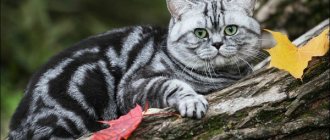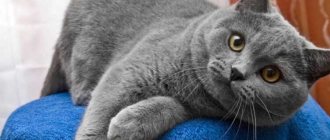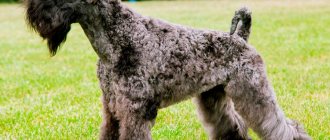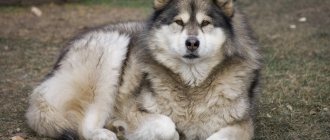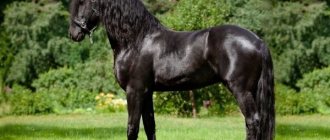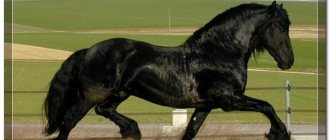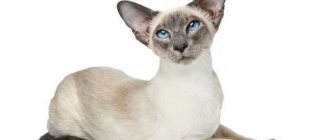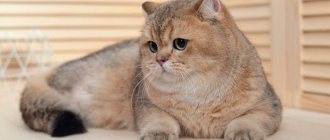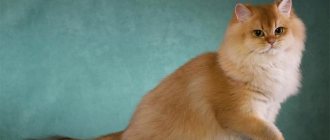British cats are distinguished by their coat palette: diverse, complex and rare in color. The British lilac, recently bred by English selectors, delights with the richness and sophistication of its color. With shades of varying intensity, it appealed to fans of the British cat breed and became popular.
Features of color
Of the two hundred different colors of animal fur, the lilac Briton delights with its tenderness, subtlety, lilac or lilac tones. The peculiarities of this color are the following shades: gray-pink; lavender; isabella Felinologists can distinguish every subtle tone. This color is difficult to both describe in words and convey in photographs.
The light one is reminiscent of lavender, akin to pink with a cool silvery tint;
The middle one is called warm lilac, close to cream with a slightly purple tint;
Dark or isabella, like coffee diluted with milk.
What causes color to form?
The color of a person’s eyes is primarily determined by heredity, but “technically” it develops as a result of a unique combination of the following factors:
- blood vessels in the iris give it cool shades: blue, gray and blue;
- the saturation of cells with melanin makes the eyes darker.
Thus, all existing eye tones are the result of a unique combination of blood vessel volume and degree of pigmentation. A low melanin content makes the iris light and cold, and its increased concentration in the cells gives it a rich, deep and warm color.
Origin of color.
At the end of the last 29th century, English breeders worked on the breed for 10 years. Experimental matings were carried out between cats and cats of chocolate color with a strong gene and blue cats with a weak one. As a result of painstaking work, we achieved an amazing result: a lilac British cat of an exclusive color. The color was adopted by felinologists 30 years ago, registered as an independent standard species with the official international names Lavender and Lilac, the breed and color are indicated in the passport with the letter “c”.
History of appearance
The British Shorthair originates from England and has been known since the 19th century. The British lilac cat owes its appearance to the many years of work of breeders and breeders. Lilac Britons are not a separate breed, they are just British Shorthair cats with the most popular shade of lilac fur.
The unusual color was formed not under the influence of a color gene, but as a result of crossing recessive forms of animals of chocolate and blue colors. Moreover, only 25% of the offspring have this color.
There is a misconception that the purple coat color is the result of crossing a Scottish Fold and a marbled cat. But such crossing not only does not give the desired color, but also leads to genetic failures.
The lilac color of British cats is popular not only in the UK, but throughout the world.
British Shorthair
Shorthair British lilac cats are large animals with a powerful, proportional body, with hair uniformly distributed in color throughout the body. The weight of males can reach up to 6 kg, females are much lighter, up to 4 kg.
Description of the standard nuances that British lilac has:
- The head is large with rounded outlines, a wide nose, plump cheeks covered with wool of a basic tone;
- The fur on parts of the body is evenly colored along its length;
- On the neck of the British Lilac cat there is a necklace in the form of a small fold;
- Short, strong paws with pinkish pads;
- The fleshy tail is colored to the rounded tip;
- Widely spaced, medium-sized ears with slightly rounded tips are covered with wool of a basic tone;
- Eye color varies depending on the shade; copper; amber; orange.
Development of kittens (+ table)
Development of kittens (+ table)
Kittens are born small (weight 60-115 g, average body length 12 cm) and completely helpless, blind and deaf; all they can do is find their mother’s nipples, sleep and suck.
They cannot even get rid of excrement products on their own; to do this, the cat licks the appropriate places for them and eats their feces. However, they grow and develop quickly, and watching this process is a fascinating activity! Already a few days after birth, kittens begin to “knead” their mother’s belly with their paws, stimulating the secretion of milk (I wonder who taught them this?) They try to crawl, helping themselves with their front paws. At the age of seven days, a kitten can already crawl several tens of centimeters. At approximately 10-14 days of age, kittens' eyes begin to open.
. At this age, the eye color of all kittens is blue; it will change to the final adult color (“rebloom”) later, at the age of 3 months. At the same time, the ear canal opens and the kittens begin to hear.
In the third week
of life, kittens begin to erupt milk teeth (later they will be replaced by permanent ones). Their vision and hearing improve and they begin to explore the world around them. By the end of the first month of life, they can sit, move quite confidently and learn to play with each other. At one month of age, kittens become interested in trying foods other than their mother's milk.
Kittens older than 4 weeks become even more active and strive for independence. If before this they mainly explored their “nest,” now they are trying to get out of it. The cat spends a lot of energy maintaining order in the family and putting the children in their place. But the activity of kittens is growing by leaps and bounds, although at this age they still do not stray far from their mother. At this time, you need to place a tray next to the nest so that, following the example of their mother, the kittens become accustomed to cleanliness and neatness. Kittens that have been taught to do their business in the litter box by their mother cat will not have any problems with the toilet in the future.
From a month to one and a half months, kittens are very active, learn to lick themselves, play with each other and with their mother, and begin to eat solid food. There is an idea that at this age they can already be taken away from their mother and transferred to new owners. However, this idea is fundamentally incorrect. It is at the age of 1-3 months that kittens watch their mother and learn everything from her. Up to two months, the cat continues to feed the kittens with her milk, which provides them with good immunity to diseases. Therefore, it is not recommended to give away kittens before 2.5-3 months.
.
Complementary feeding of kittens is carried out as follows
. At the age of three weeks, kittens can be offered to drink milk from a saucer (about one teaspoon). Then you can offer some kitten food (see feeding kittens here). After a couple of days, a little baby food should be added to dairy foods, and after another week, it is recommended to replace one daily feeding with a small amount of canned meat. One month old kittens are fed approximately 4 times a day, in addition to their mother's milk. Feed portions are gradually increased. At one and a half months of age, a kitten should eat approximately 3-4 teaspoons of food per feeding.
How to get color
Breeding lilac British cats, this rare color, is almost difficult for owners to obtain at home. Purposeful, painstaking selection by experienced breeders, with the selection of parental pairs, with knowledge of genetics, only in 25% ends in obtaining the desired result, like the producers.
Obtaining colors depends on the presence of certain pigments in the animal’s fur in the form of two melanins:
- pheomelanin - red-yellow,
- eumelanin – black.
The final shade affects the ratios in which these pigments are found in relation to each other. Even when a cat and cat become carriers of the desired gene, there is no firm certainty that the kittens born will be of a rare color. Therefore, practicing breeders do not recommend mating two lilac sires with each other. Such mating results in offspring with a grayish dirty tone in color, and the pink note disappears.
Experienced breeders achieve the birth of standard lilac offspring by breeding cats and cats of blue and chocolate color, which contain recessive genes.
When only three variants of parental pairs are mated, they get different colors in intensity, if towards purple:
- + blue, light reminiscent of lavender;
- + chocolate, medium close to cream;
- + black, dark or isabella;
Kittens
The color of a child's coat from birth differs in color as it matures. By the age of one and a half years, the tone gradually changes and becomes purple. The initially gray-blue tint of the paw pads, nose and edging of the mucous membranes begins to acquire the main color, and the blue and gray eyes become yellowish, golden or copper. Up to 5 months, kittens have grayish spots and stripes, but then in purebred lilac kittens, the attachments disappear. In a mature pet, the fur becomes the same color out of three possible shades.
Video “Funny British cat babies”
The video shows newborn kittens of lilac and chocolate color.
Was this article helpful?
Thank you for your opinion!
The article was useful. Please share the information with your friends.
Yes
No
X
Please write what is wrong and leave recommendations on the article
Cancel reply
Rate the benefit of the article: Rate the author ( 1 vote(s), average: 5.00 out of 5)
Discuss the article:
Who is the lilac Briton suitable for?
When choosing a Lilac pet, the important arguments are:
- British kittens, like their parents, have the same lilac-colored characteristics that will be a source of pride for their owner.
- The British have a soft, good-natured character; pets immediately become family favorites.
- Lilac is brought into a home with small children, and they get along well.
- They tolerate loneliness calmly and do not get bored, which is important for busy owners.
- Balanced by nature, they are clean and will not create a mess in the house.
Character and behavior
The character of these cats is independent, quite independent. They are characterized by impressiveness, sedateness, good manners and a developed sense of tact. They know how to spend time alone and need personal territory. They don’t like being forcibly held, squeezed, or stroked.
At the same time, the British are able to tenderly become attached to people, without singling out the main owner in the family, and are friendly towards children, if they do not allow themselves too much.
Be careful with strangers; the cat will need time to get to know the guest; you should not speed up the process. Get along well with other pets. The combination of self-sufficiency with kindness and intelligence makes them excellent friends for owners who spend a lot of time outside the home.
The right approach to feeding
The Lilac Briton's diet should be healthy and balanced. If the cat is on natural feeding, the following food should be present:
- turkey;
- chicken;
- rabbit;
- veal;
- eggs;
- vegetables;
- cereals
Veterinarians from the Zoovet clinic do not recommend giving fish and fermented milk products more than once a week. If necessary, the diet can be diluted with industrial complementary foods, but when choosing them it is important to take into account the gender, age and health status of the pet. It is recommended to focus on premium segment feeds.
When do major changes occur?
The first changes in the shade of the cornea can be seen already in the fourth week of a kitten’s life. Melanin begins to concentrate in the pigment centers of the iris, and gradually small patches of a different color appear on the bluish field.
By 4 months, you can get an impression of the approximate color of the pupils. The final shade will be established only upon reaching the age of two, when the formation of the body is completed and the kitten enters the maturity phase.
Since the shade of the iris is a determining factor for the breed, it is recommended to choose a kitten at the age of 4-6 months. At this time, even an inexperienced breeder will be able to correctly determine whether the future pet meets the breed standards.
